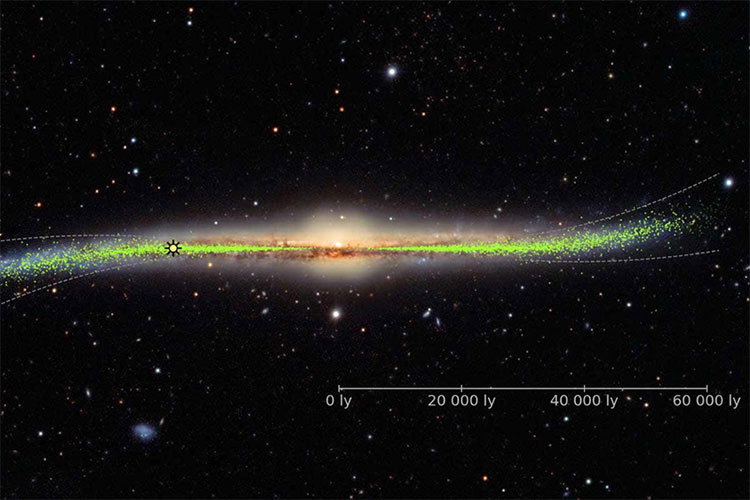The Milky Way is twisted, not flat
Released in the famous American Journal of Science last week, scientists came from the Astronomical Observatory of Warsaw University measuring the distance of thousands of stars changing the glow in the Milky Way, or called variable stars, to determine their coordinates.
By comparing and synthesizing the brightness data of the variable star , Polish scientists built the most accurate map of the Milky Way ever .

With about 250 billion stars, the Milky Way is not as flat as people think it is warped in an S-shape. (Photo: J. Skowron).
According to the 3-dimensional sketch map, our galaxy is not a flat disk, but it has four spiral arms, with one side curving upward and the other bending downwards like an S-shape. The thickness of the disc is not the same, it flares toward the edge of the twisting branch, which is described like two jeans tubes of the 1970s.
The team also found that the variable stars have a younger age, often near the center of the Milky Way, and that the variable stars of older ages are far away. Computer simulations have shown that star formation events occurred 64 - 175 million years ago, leading to the formation of variable stars like today.
According to the Journal of Science, research helps scientists see the galaxy in a whole new way. For years, astronomers had to rely on measurements from other galaxies to deduce the Milky Way's size and shape.
However, new data, including photolithic maps of Polish researchers and a map of billions of stars taken by Gaia satellite Europe, are helping astronomers determine their location. I am among the stars in the sky.
- How to see the Milky Way?
- The Fairy Galaxy will not "swallow" the Milky Way
- Enjoy the pure Milky Way season
- Instructions on how to change the flat interface for Facebook on your computer
- Learn about flat foot syndrome - the cause and treatment
- Fun little-known facts about the Milky Way
- Theory against the whole world of Flat Earth Society
- Ancient map of 'flat earth'
- The mass of the Milky Way
- The Milky Way had 'devoured' another galaxy billions of years ago
- Bizarre spiraling old tree garden attracts tourists in Canada
- The Milky Way might contain 100 million black holes
- The Milky Way has died once, we live in its second
- The Milky Way has no numerical date
 Van Allen's belt and evidence that the Apollo 11 mission to the Moon was myth
Van Allen's belt and evidence that the Apollo 11 mission to the Moon was myth The levels of civilization in the universe (Kardashev scale)
The levels of civilization in the universe (Kardashev scale) Today Mars, the sun and the Earth are aligned
Today Mars, the sun and the Earth are aligned The Amazon owner announced a secret plan to build a space base for thousands of people
The Amazon owner announced a secret plan to build a space base for thousands of people